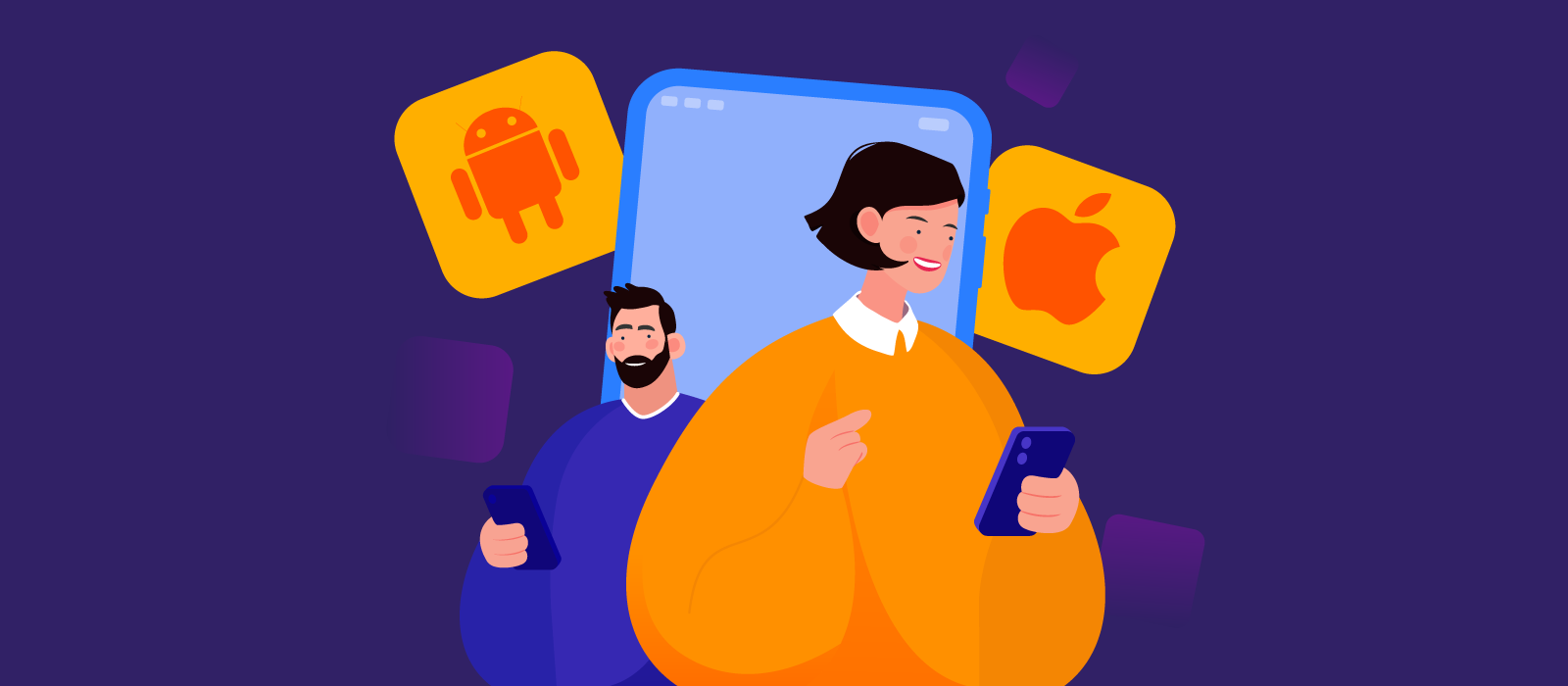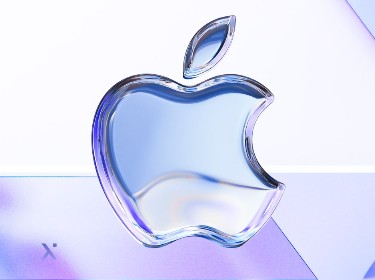When did you last use your smartphone — five minutes ago? Or perhaps right now you’re reading this article via a mobile browser? Either way, it’s clear that mobile applications are something we deal with dozens of times every day.
As smartphones and tablets play such an important role in modern life, simplifying routine tasks, it’s not hard to see that creating successful software for them will potentially provide you with a stable source of passive income.
By way of illustration, the forecasts of IT market experts predict that the market for mobile development products will expand considerably, reaching $366.34 billion by 2027 (from $170.52 billion in 2020). Helping to bring this growth about will be the development of mobile technologies such as geolocation, augmented and virtual reality, and UI personalization based on artificial intelligence.
So it’s the perfect time to find out which mobile platform to choose for starting your own business: iOS or Android. We will talk about this below and evaluate all the pros and cons of iOS vs Android development.
Planning to innovate with app development? Check out our Telegram Mini App development services
Parameters to take into account when you choose the mobile OS
As practice shows, when you’re trying to choose the right mobile OS it’s important to evaluate the following:
- market share, user location, and the users’ ages
- revenues and typical methods of monetization
- LTV of users
- capacity or customization
- trend technologies prospects
- security level
- cost to develop and time to market
- time needed for app review
- ASO (App Store Optimization)
- maintenance costs
Below we will expand on all these subtopics.
Market share, user location, and age groups
![]()
Let’s start with the Android vs iOS app development market overview.
Currently, iOS-based products have a share of about 21% of the mobile market, while Android solutions have about 73%.
At the same time, the app development iOS vs Android stats suggest that in 2020 the expenses of iOS users in the Apple App Store were almost twice as high as those of Android users in the Google Play Store.
Now let’s analyze the territorial distribution of owners of devices based on iOS and Android, using relevant data from iOS vs Android development stats:
- Asia. Probably no one will be surprised that the most popular mobile OS here is Android. The market share of this platform accounts for almost 83% of mobile devices. As for India, the percentage of iOS-based gadgets owners here ranges from 2-4%. If we are talking about China, then Statista’s forecasts suggest that by 2023 the country will probably lead the world in the number of downloads of mobile applications per year (about 174 billion!).
- Africa. As the second most populous region, Africa is an extremely attractive territory for Android product developers. Currently, these devices occupy about 87% of the market. iOS only secures 10%.
- North America. Due to the relative prosperity of the population, iOS is the leader in this region, accounting for over 53% of the total number of smartphones.
- South America. Here the population has more moderate incomes, giving preference to the budget segment of devices based on Android (more than 88% of smartphones here are based on this OS).
- European countries. More than 69% of mobile gadget owners have Android smartphones, and about 30% of users choose iOS. When it comes to the UK, Android devices account for about 53% of the mobile gadgets niche, while iOS devices make up about 47%
- Australia. Here the competition is less intense, with Android devices having a market share of almost 58% compared to almost 42% for iOS devices.
Now for a few words about the age range of Android and iOS users, which is useful to know when choosing between Android vs iOS app development. According to Statista, about 44 percent of iOS device owners are 16-24 years old, while about 30 percent of respondents in the same age range were Android device owners. Take note of this when choosing between the two OSs.
See how our mobile development services can help you get ahead
Revenues and monetization
Despite the unspoken assumption that the bulk of financially secure users are owners of devices based on iOS, it is wrong to claim that Android users don’t want to pay for apps. For one thing, most of the world’s mobile users have Android smartphones, among which there are models in the middle and high price segments which cost the same or even more than Apple devices. Equally, there are increasing numbers of iOS device owners who are not ready (for whatever reason) to part with their money in favor of paid software.
Therefore, despite the fact that iOS users still spend more money on applications than Android users (the difference was almost $9 billion in 2020), the user base of the latter OS is still so large (as you can see, the market capitalization is estimated at billions of dollars) that you shouldn’t worry about the lack of potential users of your future software.
What’s more, the choice of the platform depends on the selected monetization strategy. Therefore you have to decide:
- where you plan to receive income: from installing the application or from embedded advertising
- whether there will there be paid features and premium accounts
- whether your target audience is ready to make in-app purchases.
So what about monetization for iOS and Android? Previously, the Android store had a lot of free apps that made money only by advertising, while on iOS, in contrast, there were many products that could only be downloaded at a cost. These days the monetization strategies for both platforms are almost the same — paid and free apps are available on both Android and iOS.
But most popular on both platforms is the shareware model: the user does not pay for the download but subscribes to the opportunity to use it further or buys something within it.
LTV of users
![]()
LTV or customer lifetime value is one of the most important indicators in marketing. With its help you can get the measure of customer interest in your product.
The LTV indicator allows you to calculate the amount of profit that you receive from one client for the entire time of your association with them. In the context of mobile development for each OS, it is important to understand how long applications based on a specific platform are used by a specific smartphone owner.
On average, the in-app purchase price is $1 for iPhone users and $0.47 for Android. In other words, AppStore customers are much more willing to spend money and make in-app purchases.
In addition we’ve found a very detailed survey in which the cost indicators for users of each OS are compared with the duration of their use of the software:
- For the Android vs iOS game development: within 90 days, iOS device owners spend 28 percent more than Android device owners;
- For shopping: here the gap is even more impressive in favor of iOS, amounting to 70 percent;
- For travel: the difference between the level of expenditure of iOS and Android users in this segment is 50 percent in favor of the former.
As you can see, iOS wins in all popular niches of mobile development.
Check out this blockchain-powered, sports mobile app that motivates its users to work out and stick to their training plans
Customization
Let’s turn to the customization of mobile app development Android vs iOS. If there are no problems with a variety of application functionalities in any of the platforms, then from a design point of view developers still have to adjust to the nuances of each OS.
In particular, iOS and Android are characterized by a number of fundamental design differences. As we can see, the main feature of the Apple icons and buttons style is their minimalist and economical Flat Design.
Android designers are inspired by a roughly similar Material Design idea. What’s more, the latest versions of the Android OS clearly cater to the desire to make the most of the touchpad of mobile devices, without physical buttons.
Regarding the look of the multitasking bar on the two platforms, iOS uses separate windows in a miniature view, while Android uses sequential tabs that take up almost the entire screen.
Both platforms also differ in button style. Android has floating buttons that cast a shadow, while the stylistic concept of iOS involves an extremely simple and ascetic design for all user interface elements. This rule also applies to icons: the creators of iOS insist that the lines used in icons be as thin as possible (unlike their counterparts in Android).
Note that over time the interface of systems and applications becomes more unified. The latest versions of Android have a great deal of native elements, just like iOS.
In general, though, we can see that the Android developers have a few more opportunities to adapt the design of the application for something branded.
Trend technologies prospects
![]()
In this section we’ll discuss the iOS vs Android development future.
As you know, last year Android introduced the latest version of the operating system, Android 11 “R”; in the process, it upset many users with the cancellation of hardware support for applications based on the Google Daydream platform.
On the other hand, now Android developers will be able to focus their attention on the creation of native software for the branded Google Pixel smartphones. This includes the ability to easily find friends who have decided to share their location using Google Maps in augmented reality mode, as well as “smart” answer tips when communicating in chats and also situational application recommendations based on user actions.
The Apple developers are also ready to keep us happy by introducing iOS 15. Here they have improved the possibilities for collaboration, optimized the mechanisms of interaction with cards, improved the user data privacy indicators, and provided new voice control capabilities. In terms of tools for creating augmented reality solutions, users have RealityKit 2 with its advanced 3D rendering capabilities.
Find out more about this enterprise IoT mobile app and data gathering solution
Security
Now we’ll turn to the Android vs iOS development differences in the security field.
Apple’s key idea was to provide complete control over the source code for all its software products. Therefore, non-Apple developers currently have only partial access to elements of this platform. This approach is underpinned by uncompromising statements from Steve Jobs. In particular, the inspirer and creator of Apple repeatedly and publicly criticized the open-sourced Android solutions, choosing a fundamentally opposite approach for his own company’s branded products.
Technically speaking, iOS is based on the Mach microkernel and the Darwin system. The latter fully complies with the UNIX SUSv3 specification, but in practice, this doesn’t mean that the iOS platform is open source (as a typical UNIX system would be).
What does the closed code of Apple provide? Primarily, total control over the results of both in-house and third-party developers working on products for the company.
On the one hand, the introduction of such policies by Steve Jobs has frequently puzzled many IT companies willing to work for the good of Apple. However, having gained an impeccable reputation, the creator of Apple could not afford to disappoint consumers and therefore decided to release software and hardware solutions with guaranteed quality and reliability.
As for Android, now the property of Google, this OS from the very beginning positioned itself as a notably easy-to-use and budget platform for mobile applications (compared to iOS). The successful release of this version, which in all technical aspects was supposed to successfully compete with iOS, took place with the support of such giants as HTC, Samsung, and Motorola at the end of 2009.
This platform is based on the Linux kernel. It is the complete embodiment of the concept of open-source software. This means Google allows developers to make improvements or even dream up their own OS.
As for mobile devices using the Android operating system, many consumers see them as budget alternatives to iOS devices (even though today there are plenty of gadgets that are pricier than Apple products).
Naturally, for ordinary users the price factor is fundamental to the iOS vs Android competition, as evidenced by these statistics. As you can see, in the consumer segment Android has been holding the upper hand over its iOS rivals for more than ten years.
On the flip side, it’s fair to say that open source has its drawbacks. Because unfortunately owners of Android devices often face problems in the form of various viruses and other hacker software that can seriously harm the operation of mobile devices. For its part, a solution developed by an experienced iOS app development company leaves no loopholes for malware to exploit, which ensures it is a more reliable operating system.
Cost to develop and time to market
![]()
It is not easy to say which option — the iOS development vs Android development — costs less. This is because the final pricing for Android app development vs iOS app development depends on the complexity, number of functions, deployment features, and the rates of the contractor company, and not on the platform itself.
But which type of mobile app development — Android vs iOS app development — is faster? We can say this about the iOS vs Android development time: since iOS applications are developed for devices with a limited model range, testing costs are lower. As for Android devices, the developers encounter a wide variety of manufacturers and screen sizes. This complicates the procedure for adapting the user interface for all existing devices using the Android platform as the OS, and entails additional financial and time costs.
For iOS, the situation is much more transparent. There is less diversity of device format, so it is not difficult to create mock-ups at the required scale. In addition, these mock-ups are facilitated by special device emulators (for example, the official Apple product, iOS Simulator, launched through Xcode), which allow specialists to test an application using various combinations of OS and hardware versions.
Meanwhile, Android is ideal for creating MVPs, since the cost of the services of an Android development company in the global IT services market is slightly lower, with iOS developers on average charging around 20% more than Android developers.
Take a look at this web & mobile IoT solution for BMW dealer showroom services
Time needed for app review
Now let’s talk about the time you need to wait until the application, after being uploaded to the store, will become available to ordinary smartphone users.
For the App Store, it takes about 1-2 days. About half of all applications are tested on the first day, with most of the rest tested on day two. Applications can be postponed, if the package is not complete, or rejected if they do not comply with app store policies.
As for the Google Play Store, it takes three days to check the software. This is considered the standard review period: sometimes it can take a week or more.
You may think that this is an insignificant waiting time when we’re talking about the launch of the first release. However, when you need to regularly release updates, many of which are bug-free versions of the first version of the software, a delay of one day can be critical.
However, as you may know, there are frameworks for creating mobile software that allow you to download updates, bypassing Apple’s app review deadlines. As for the release of updates for the Android platform, developers can launch new versions of their software products every two hours.
ASO (App Store Optimization)
App Store Optimization is regarded as a vital tool for iOS and Android businesses that helps boost visibility and conversion rate, enhance search rankings, and, crucially, bring more organic app installs.
Despite the fact that the Apple App Store and Google Play Store serve the same purpose (enable users to find and download applications), each of them has its own algorithms used for ranking apps in the search results and displays their apps differently.
Now let’s delve into how the key parameters of the two app stores differ:
App title: in the Google Play Store, the title tends to be a bit more important since the user will see only the icon and name of an app in the search results. In the Apple App store, though, apart from the app’s name and title, the user can view subtitles and screenshots in the search results.
Plus, remember that each store has its own character limit — 30 characters for iOS apps and 50 characters for Android apps.
Subtitle (iOS) and a short description (Android): the subtitle of an iOS app shouldn’t exceed 30 characters and it appears below the app title in the search results and below the screenshots on the app page. The short description limit in Android apps is 80 characters. The description is normally shown only on the app listing below the screenshots.
Keyword field: in the Apple App store, keywords are essential — there is even a special 100-character keyword field — but they aren’t visible to the user. As for the Google Play algorithms, they don’t focus on a keyword field. They look at the keywords provided in the app title, subtitle, and the keyword frequency in the long description.
Screenshots: in the Google Play Store, you can add a maximum of 8 screenshots. They have a smaller size in the search results compared to the Apple App Store, where their number is limited to 10. Consequently, screenshots play a more prominent role in the Apple App Store in terms of conversion rate optimization.
App previews (iOS) vs promo videos (Android): Apple allows you to add up to 3 preview videos (but only 1 of them will be shown in the search results alongside the 2 screenshots and autoplays). Moreover, remember that preview videos for the Apple App Store must be short and relevant. In the Google Play Store, promo videos are showcased on your app listing before the screenshots and are autoplayed in the search results for a branded search. Mind that this store allows you to add just one video, and it’s advisable to shoot it in a YouTube format.
Backlinks: the Google Play algorithms look at the number of backlinks to the app webpage so as to check the app authority. The more backlinks you provide, the higher rankings you’ll have. With the Apple App Store, though, you don’t have to create backlinks to the Apple webpage. Still, they may turn out to be beneficial in terms of the app branding and marketing strategy.
Maintenance
![]()
Alongside the iOS vs Android development costs, you have to bear in mind the fees for maintenance.
Obviously, the lifecycle of your mobile app does not end at its first release. In addition to the costs of publishing your software on Google Play and the Apple App Store (if you are a developer), you may need to monitor daily active users (DAU) in order to objectively assess the popularity of an application by the number of installs.
A separate item of expense is made up of post-release software maintenance. We won’t discuss here the costs involved in hosting, automated messaging services, payment gateways, marketing, and other components that ensure the viability of your application, but remember that you should not depend on the platform you choose. In general, you’re required to pay approximately 40-50% of your initial project budget in the first year, with the amount gradually decreasing to 10-30% over the next few years.
But there are two fundamental factors that are closely related to the mobile platform you have chosen. First, the need to fix bugs and to release updates. Here you will have to turn to the services of developers whose rates, depending on their expertise (as we noted above), can significantly differ. Second, the cost of the developer’s account in the app store. Specifically, developers have to pay $25 on Google Play and $99 on Apple App. These costs will not affect you if you hand your mobile software development over to a company that specializes in this service.
Closing thoughts
So, what is better: Android development vs iOS development? And which platform should you choose first for building your application? As experience on the ground shows, the choice is very simple: as your application develops, you will need to create both versions. When it comes to choosing between iOS development vs Android development, you should ask yourself the following questions:
- Who are my main adopters?
- What is my monetization strategy?
- What are my mid- and long-term business goals?
If you still don’t know which platform to go for, simply contact us and we will help you to figure out which option — iOS vs Android app development — is better for you. We can also estimate the budget of your project and give you detailed feedback about Android development vs iOS development costs. Plus, we at PixelPlex provide cross-platform app development services. Our mobile developers will create a unified mobile software solution for both of the platforms at once, making the pros and cons of iOS development vs Android irrelevant.




